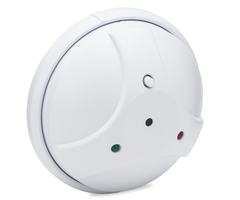How Do I Test a 2GIG GB1?
You can test a 2GIG GB1 by using a glass break simulator, such as the Honeywell FG701. This device will produce a noise that is designed to imitate the sound of breaking glass. When this noise is heard by the 2GIG GB1, the sensor will activate and cause a fault on the designated zone.

The 2GIG GB1 works by listening for the sound of breaking glass. Both the "thud" of an object striking the glass and the "shattering" sound of the breaking glass must be present for the device to activate. To reproduce this sound for testing purposes, it is necessary to use a glass break simulator. An excellent glass break simulator for this purpose is the Honeywell FG701.
Complete the following steps to test a 2GIG GB1 Glass Break Detector:
1. Place the GB1 in test mode. Before testing the GB1, you must place the device in its test mode. This will have it listen for the frequency produced by a glass break simulator. The test mode for the GB1 is not the same as the test mode for the security system. When the GB1 is in its test mode, you will be able to more reliably trip the device using your glass break simulator. This device-only test mode is only necessary for testing the device, and the GB1 should not be in its test mode for general use.
To place the GB1 in its device test mode, press and hold the test button on the GB1 for five seconds, then release it. The green LED light on the device will blink twice to indicate that the device has entered into test mode. The device will automatically exit test mode after 90 seconds.
The picture below shows the test button on the GB1:

2. Test the device. Using the glass break simulator, activate the sound of breaking glass to trigger the 2GIG GB1. When doing this, you will want to be standing near the glass so you can perform the most accurate simulation possible. You will also want to point the speaker of the simulator directly at the glass break detector so that the GB1 can properly hear the sound. If you are using a Honeywell FG701 to perform the test, you will want to make sure its switches are set in the correct position and that the batteries in the device are fresh.
Remember, the FG701 will only produce the "shattering" sound of breaking glass. You will still need to produce the low-frequency "thud" sound of an object striking against the glass. You can produce this sound by gently tapping against the glass with your hand. When the FG701 hears the thud of the glass being struck, it will then produce the "shattering" sound. The GB1 will only activate if both the "thud" and "shattering" sounds are present.
If the test is successful, a green LED light on the 2GIG GB1 will acknowledge the "thud" sound, and a red LED light will acknowledge the "shattering" sound. Once the test has been complete, you will not need to take the device out of test mode, as the GB1 will exit the mode on its own after 90 seconds.

3. Repeat the test. Repeat this test in all four corners, as well as the center of the glass that is being protected. If the 2GIG GB1 will activate in test mode for each of these locations on the glass, you have a reasonable assumption that it will trip in normal mode when glass is broken.
Did you find this answer useful?
We offer alarm monitoring as low as $10 / month
Click Here to Learn MoreRelated Products
Related Categories
- Answered


